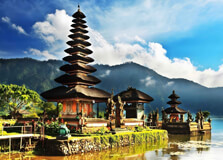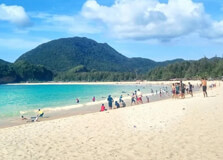
- Home
- Travel Packages
- Top Destination
-
Travel Attraction
By Category
Top Attraction

- Travel Agents
- Car Rentals
- Hotels

Located on the northwestern coast of Bali, Lovina Beach is a popular destination known for its black volcanic sand, calm waters, and stunning sunsets. Unlike the crowded beaches of southern Bali, Lovina offers a more laid-back and peaceful atmosphere, making it an ideal spot for relaxation and rejuvenation. Water Sports While Lovina Beach may not offer the same variety of water sports as some of the busier beaches in Bali, visitors can still enjoy activities such as snorkeling, diving, and dolphin-watching tours. The calm waters and abundant marine life make it a great place for underwater exploration. How To Reach Lovina Beach is located approximately 2.5 hours by car from Bali's Ngurah Rai International Airport. Visitors can hire a private car or taxi to reach Lovina, or opt for public transportation such as buses or shuttle services. Alternatively, many tour operators offer day trips to Lovina Beach from popular tourist areas in Bali. Best Time To Visit The best time to visit Lovina Beach is during the dry season, which typically runs from April to October. During this time, the weather is sunny and warm, with minimal rainfall. The peak tourist season in Bali is from July to August, so visitors looking to avoid crowds should consider visiting during the shoulder months of April, May, September, or October. Places To Stay Near Lovina Beach There are plenty of accommodation options near Lovina Beach, ranging from budget guesthouses to luxury resorts. Some popular hotels in the area include The Lovina, Puri Bagus Lovina, and Lovina Beach Resort. Staying in a beachfront villa or bungalow is a great way to enjoy the stunning views and peaceful atmosphere of Lovina Beach. Traveller Tip One of the highlights of visiting Lovina Beach is the chance to witness dolphins swimming in the open sea. To increase your chances of spotting these playful creatures, consider booking a sunrise dolphin-watching tour with a local boat operator. Remember to respect the natural habitat of the dolphins and avoid overcrowding or disturbing them. Things To Carry When visiting Lovina Beach, be sure to pack essentials such as sunscreen, sunglasses, a hat, and a reusable water bottle. If you plan on participating in water activities, don't forget to bring your swimsuit, snorkeling gear, and underwater camera. Comfortable footwear and lightweight clothing are also recommended for exploring the nearby attractions. Tourist Attractions To See In And Around The Lovina Beach Aside from the beach itself, there are several tourist attractions to explore in and around Lovina Beach. Some popular sights include the Banjar Hot Springs, Brahma Vihara Arama Buddhist Temple, and Gitgit Waterfall. Visitors can also take a day trip to nearby towns such as Singaraja or explore the natural beauty of the Bali Barat National Park. Shopping While Lovina Beach may not be known for its shopping scene, visitors can still find souvenirs, handicrafts, and local goods at the nearby markets and shops. The Lovina Art Market is a great place to pick up traditional Balinese artwork, textiles, and handicrafts. Don't forget to bargain for the best price and support local artisans. Nightlife At Lovina Beach While Lovina Beach is not a party destination like some of the southern Bali beaches, there are still plenty of options for nightlife in the area. Visitors can enjoy relaxed evenings at beachfront bars, cafes, and restaurants, listening to live music or watching traditional Balinese dance performances. For a more lively atmosphere, head to nearby towns such as Kalibukbuk or Singaraja for a taste of Bali's vibrant nightlife scene.
Explore More
Lampuuk Beach is one of the most stunning and serene beaches located near Banda Aceh, Indonesia. Known for its pristine white sands, clear turquoise waters, and dramatic natural scenery, it has become a favorite getaway for both locals and tourists. Lampuuk Beach is not only a place to relax but also a symbol of resilience and recovery after being heavily affected by the devastating 2004 Indian Ocean tsunami. The beach’s natural beauty combined with a tranquil atmosphere makes it a must-visit destination when traveling to Banda Aceh. How to Reach Lampuuk Beach, Banda Aceh Lampuuk Beach is located approximately 20 kilometers west of Banda Aceh city center. It is easily accessible by car, motorbike, or taxi. From Sultan Iskandar Muda International Airport, it takes around 30 minutes to reach the beach by taxi or private car. The route to Lampuuk Beach is well maintained, and the drive offers scenic views of coastal landscapes and rural villages. Visitors can also rent motorbikes for a more adventurous and flexible journey. Public transportation options are limited, so hiring a car or taxi is recommended for convenience and comfort. Weather Banda Aceh has a tropical rainforest climate characterized by warm temperatures and high humidity throughout the year. Lampuuk Beach enjoys this tropical climate with temperatures typically ranging between 25°C (77°F) and 32°C (90°F). The area experiences two distinct seasons: the wet season from May to October and the dry season from November to April. The best time to visit Lampuuk Beach is during the dry season when the skies are clear, and the sea is calm—ideal for swimming and sunbathing. During the wet season, heavy rains can occur, but short breaks in the rain still allow for beach visits. It’s advisable to check the weather forecast before planning your trip. Timing Lampuuk Beach is open to visitors at all times since it is a public beach. However, the most pleasant times to visit are from early morning to late afternoon when daylight is ample, and the temperatures are comfortable for outdoor activities. Sunset is particularly beautiful at Lampuuk Beach, drawing many visitors in the evening to enjoy the breathtaking views over the ocean. Nighttime visits are possible, but the beach is less safe and less lively after dark due to limited lighting and facilities. Why Famous for Lampuuk Beach, Banda Aceh? Lampuuk Beach is famous for its natural beauty, with powdery white sand, crystal-clear waters, and gentle waves that attract swimmers and beach lovers. It is also renowned for its connection to the 2004 Indian Ocean tsunami. The beach was severely damaged during the disaster but has since undergone extensive restoration and revitalization efforts, symbolizing hope and resilience for the people of Aceh. The beach is also known for its relatively quiet and unspoiled environment compared to busier tourist beaches in Indonesia. It is an excellent spot for visitors looking to experience nature in a more peaceful setting, away from large crowds and commercial developments. Entry and Visit Details Entry to Lampuuk Beach is free of charge. As a public beach, it welcomes everyone year-round. There are no official opening or closing hours, but visitors typically enjoy the beach during daylight for safety and comfort. Facilities near the beach are limited but include a few small warungs (local food stalls) offering refreshments and snacks. Basic amenities like restrooms and parking areas are available but may be simple. Visitors are encouraged to bring their own necessities such as water, towels, and sun protection. History and Architecture While Lampuuk Beach itself is a natural formation, its history is closely linked with the 2004 Indian Ocean tsunami, one of the deadliest natural disasters in recent history. The tsunami caused massive destruction to the coastline, including Lampuuk Beach, wiping out homes and natural landscapes. In the years following the disaster, significant efforts were made by local communities, government agencies, and international organizations to restore the beach area and rebuild the local economy. Today, Lampuuk Beach stands as a symbol of recovery and the spirit of resilience of the Acehnese people. Architectural structures in the area are mostly traditional houses and small shops built in simple styles typical to coastal Aceh, emphasizing practicality and harmony with the environment. Things to Do at Lampuuk Beach Lampuuk Beach offers a variety of activities that visitors can enjoy, including: Swimming and Sunbathing: The calm and clear waters make it safe and enjoyable for swimming. The white sandy beach is perfect for sunbathing. Beach Walks: Take long, peaceful walks along the shoreline while enjoying the stunning sea views and gentle breeze. Photography: Capture beautiful landscapes, sunsets, and local life on the beach. Picnicking: Bring food and enjoy a picnic on the beach under the shade of coconut trees. Surfing: During certain seasons, the waves at Lampuuk can be suitable for beginner surfers. Explore Nearby Villages: Visit the nearby fishing villages to learn about traditional Acehnese coastal life. Interesting Facts About Lampuuk Beach Lampuuk Beach was one of the hardest-hit areas during the 2004 tsunami but has since become a symbol of hope and renewal. The beach remains relatively less commercialized compared to other Indonesian beaches, offering a more natural and peaceful experience. Local fishermen still use traditional boats and methods, giving visitors a glimpse into the region’s maritime heritage. The beach is part of a coastal ecosystem that includes mangroves and coral reefs, important for local biodiversity. Lampuuk Beach is gaining popularity among eco-tourists and travelers looking for off-the-beaten-path destinations. Tips for Visiting Lampuuk Beach Visit during the dry season (November to April) for the best weather and sea conditions. Bring essentials such as sunscreen, water, and insect repellent, as facilities can be basic. Respect the local environment by disposing of trash properly and avoiding disturbance to wildlife. Try local food stalls near the beach to enjoy traditional Acehnese snacks and refreshments. If you plan to swim, be mindful of tides and avoid swimming too far from the shore. Consider hiring a local guide if you want to explore surrounding villages or learn about the area’s history. Arrive early in the morning or late afternoon to avoid the midday heat and enjoy more peaceful surroundings.
Explore More